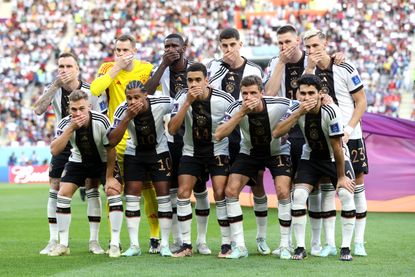I find myself in the muted stillness of a rectangular room, measuring 8 meters by 6 meters, poised on the tips of my feet. Ahead of me are the shapes of two circles outlined on the wall. Outside these confines lies a vast insulated hangar adorned with synthetic turf and populated by high-earning professional soccer […]


I find myself in the muted stillness of a rectangular room, measuring 8 meters by 6 meters, poised on the tips of my feet. Ahead of me are the shapes of two circles outlined on the wall. Outside these confines lies a vast insulated hangar adorned with synthetic turf and populated by high-earning professional soccer players. The lower circle radiates a brilliant white amid the shadows. I brace myself, waiting for the Death Star to engage its superlaser.
A second goes by.
Two seconds pass.
Clunk—pause—whoosh!
A soccer ball shoots from the illuminated opening, speeding to 35 miles per hour and streaking through the darkness, before crashing into my right foot and awkwardly spinning away. I pivot, needing two more touches before I can stabilize the ball under my control. A professional would have accomplished it in one single touch, noiselessly. The next four balls launch with equally disappointing results. I’m worried I’ll be removed from the facility due to extreme ineptitude.
Yet, there’s a glimmer of hope. Okkulo, the British firm that developed this training setup, has recently released a study showing that regular practice under limited lighting can significantly improve certain visual motor capabilities. If I invest ample time in drills within this specially illuminated space, I might just enhance my playing skills for the park come Saturday afternoons.
“The athlete will enter this box, and upon exiting, they’ll be better prepared for their match or training,” proposes Mel O’Connor, founder of Okkulo. The concept is straightforward: The more you train the systems aligning the eyes, body, and brain amidst tough lighting, the quicker and more precise your coordination will become in normal light. “We can accelerate and decelerate the processing of information between the eye and brain, which in turn works with the [connection between] brain and muscle,” O’Connor asserts. “It’s all about maximizing processing capability.”
I’m testing Okkulo’s technology at Thorp Arch in West Yorkshire, a $6 million sports facility that serves as the headquarters for one of England’s premier soccer clubs—Leeds United. Today, I’m utilizing a temporary model intended for tours across sports clubs and universities. It has been situated at Leeds for six weeks. Should they choose a permanent setup, Okkulo’s production team can craft a customized model in collaboration with the club’s goalkeeping coaches and sports scientists.
The overhead luminance transitions from mere dimness to a deep, low-level blue hue. O’Connor observes from the perimeter of the room, while Jack Woodburn, the head of sports science at the company, manages the lighting and ball-launching systems from a computer on the opposite wall. I’m practicing at a specifically selected light frequency that induces a 10 percent delay in the processing rate between the eye and the brain.
Okkulo can alternate between various light settings that influence the brain’s processing of visual stimuli in distinct ways. A low blue light tests visual focus and anticipation; green light is ruthlessly designed to stress our peripheral vision and identification skills. Switching to dim red light alters depth perception. The ultimate, challenging light mode blends all three settings, resulting in a 23 percent decrease in eye, brain, and muscle coordination. It feels nearly surreal.
Another ball bursts forth under Okkulo’s blue light, and I feel as if my body is possessed by someone else, as if the ball has gained an unexpected boost during its flight and is racing past the point where it would conventionally decelerate. I seem to have unwittingly consumed three beers, followed by three shots, and a tequila slammer.
Next, O’Connor and I toss a tennis ball back and forth. The best way to express the sensation is reminiscent of wearing 3D glasses for the first time at the movies—both familiar and disorienting at once.
Five more soccer balls careen towards me. I feel I’m starting to get into the groove, until O’Connor gains control by switching Okkulo to its green light configuration and tosses a tennis ball softly off the wall in my direction. I’m left grasping at nothingness. While I never claimed to be an excellent soccer player, it’s a wholly different experience to suddenly find yourself unable to catch.
However, with time, the brain begins to adjust. Recently, twenty-two professional soccer players from Sunderland AFC—another prominent club with a rich history, currently competing in the second tier of English soccer—participated in a six-week study of Okkulo. Initially, the players had their visual-motor skills evaluated using specialized software. Onscreen assessments gauged their ability to focus on swiftly moving objects, their reaction times, and their peripheral vision. This software also evaluated their capability to anticipate object movement and how much time they required to recognize a target object amidst other distracting visuals.
They were then divided into two equal groups, completing training drills bi-weekly under the guidance of an Okkulo coach—one group utilized Okkulo’s lighting system while the other trained under standard conditions. Beyond these sessions, both groups continued their usual training. After the six-week period, their visual-motor skills were re-evaluated with the software.
Compared to the control group, players using the Okkulo system saw their recognition time improved by nearly 60 percent on average, allowing them to identify relevant activities more swiftly amid crowded fields. Moreover, their peripheral vision identification was 10 percent more precise and 20 percent quicker, while their depth perception improved by 45 percent, and their sensory reaction times rose by 17 percent.
The overall outcome for participants in the study, as the company claims, reflects a 36.3 percent enhancement in motor reaction time—indicating that players seemed both swifter and more proficient in responding to stimuli. During reassessment with the software, they were 17 percent faster in halting one action, then 36.3 percent faster in initiating the next. If this enhancement can be replicated in genuine sports scenarios, it could signify a monumental breakthrough in boosting athletic performance.
O’Connor envisioned Okkulo over twenty years ago while working on a film set as a costume designer, captivated by how cameras responded to various light conditions. He reached out to a scientist who had authored a paper on perceiving movement in low light—and by sheer coincidence, this researcher lived only 20 minutes away. By the end of that afternoon, the two were brainstorming how this could be applied to sports training over tea. Within four weeks, they secured a £20,000 research grant from the University of Durham and began developing a basic precursor to Okkulo, which they tested with the university’s cricket team.
The initial research yielded promising results. Cricketers exposed to lower lighting conditions during training exhibited greater advancements in their batting skills compared to those in the corresponding control group. Subsequent case studies, including a notable improvement in performance during matches for a goalkeeper in the English Football League, suggested similar enhancements—but until the release of this latest study, O’Connor had struggled to explain objectively how his technology seemed to elevate athletic performance. “We could observe that we were advancing athletes, but we needed to pinpoint exactly why [the technology] was doing this. Now we’ve obtained the data to illustrate it.”
Alex Cairns, a highly experienced goalkeeper at Leeds United with over 300 appearances in the English Football League, describes working with Okkulo as a “jolt to the system.” For his goalkeeping colleague Harry Christy, who is ten years younger and at a different stage in his career, training in the chamber was a chance to seize with enthusiasm: “I’m seeking every slight improvement I can discover, every advantage I can attain over my fellow goalkeepers nationwide,” Christy remarks. Neither goalkeeper participated in the study at Sunderland AFC.
“What’s intriguing is that they have not only adjusted light levels but also altered the specific quality and wavelengths of that light,” says Niall Macfarlane, a professor in physiology and sports science at the University of Glasgow who did not take part in the research. He believes that experimenting with various types of low light—blue, red, green—offers significantly more opportunity for improvements than merely utilizing dimmed light alone.
Macfarlane does have some concerns about the extent to which the encouraging results from the research might translate into performance enhancements in an actual soccer match. “I think it’s much more applicable to sports like baseball or cricket where you can recreate the game scenario more accurately,” he posits. In contrast to the highly unpredictable nature of soccer, with batting sports “you know where the ball will be coming from, you have a good estimate of its speed, so [through the training] you can refine the tracking of that ball and ensure consistent contact.”
It’s no surprise, then, that when I arrived earlier this afternoon, O’Connor was in the midst of booking flights to Arizona. He is in discussions with over half of the Major League Baseball teams.
Yet, there remains much work ahead. Additional research is required to determine how long the advantages of the lighting training persist, as well as to verify that there were no performance biases affecting the recent study—it was clear to participants which group was undergoing the Okkulo intervention and which was not, potentially influencing their performance unconsciously. Future evaluations could address this by implementing lighting adjustments for the control group as well, to obscure which group participants belong to.
Beyond elite athletics, Okkulo is beginning collaborations with various universities to explore the possible medical applications of the technology, prompting O’Connor to envision a future where hospitals and clinics include ambient lighting rooms to assist patients recovering from severe brain injuries or paralysis. He aspires to eventually extend Okkulo’s reach into home use and commercial gym markets, following in the trail of companies like Peloton.
But for now, it’s my moment. Redemption is on the horizon. The room reverts to standard light levels. I position myself and await the ball’s arrival. My systems are finely attuned, my pulse has slightly quickened, and my senses are heightened. It’s my time to shine.
Clunk—pause—whoosh!
I manage to control the ball. It’s seamless. Graceful and silent, surrendering to my command as a lost duckling returns gratefully to the warmth of its nest. It feels like it belongs here. For a few moments, I bask in immense pride before O’Connor reveals that we’ve been utilizing a ball-speed setting designed for 10-year-olds. The technology may be cutting-edge, but even science has its limits.














